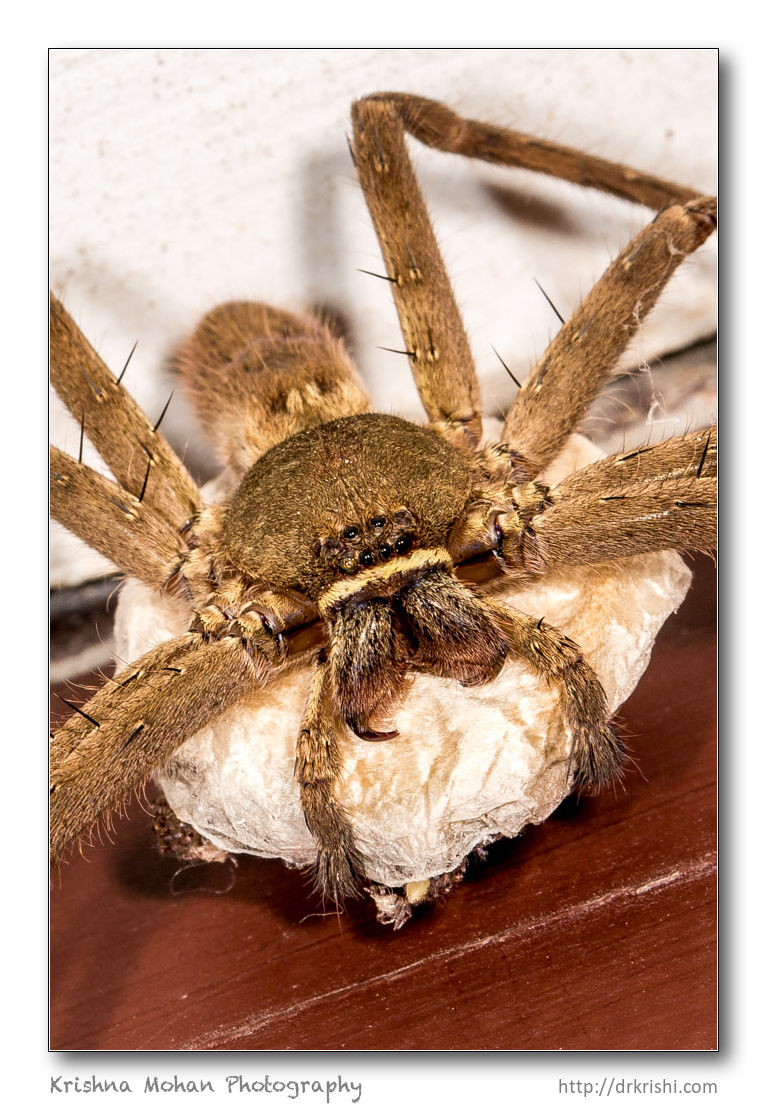
This female huntsman spider also known as common house spider (Heteropoda cf. venatoria), giant crab spider spider, banana spider (due to its occasional appearance in marketed bananas) was sitting on the wall plate of my house along with her egg sac which was full of young ones. She was placed high up at around 10 feet from the ground, that too in a corner, which did not give me enough space or angles to explore. Female giant crab spider will aggressively defend their egg sacs and young against perceived threats. But she was patient and did not hesitate to pose for me. I was able to take few shots while perched precariously on a dining chair using Canon EF 100mm f/2.8L Macro IS USM with Canon EOS 5D Mark III. The illumination was by using Canon MT-24EX macro twin light flash. You can check my earlier blog on Male Huntsman spider.

Huntsman spider which belong to family Sparassidae, is a large brown spider with a flattened body structure and very little dorsal pattern. Adult specimens have a body length of 2.2 to 2.8 cm (about 1 inch), and have a leg span of 7 to 12 cm (3 to 5 inches). Adult females have a larger body size, especially the abdomen, than males. Adult males have longer legs than females, and the long male palpi have the terminal segment enlarged and the ventral sclerites exposed, as in most true spiders. Both sexes have a yellow to cream clypeus and a wide marginal band encircling the rest of the carapace, tan in females and cream in males. In addition, males have a dark, longitudinal stripe on the abdomen and a light-bordered pale area behind the eyes. The legs of both sexes have distinct black spots from each of which arises an erectile macroseta. Otherwise, the spider is not conspicuously hairy.

Female huntsman spider makes flattened, disc-like egg sacs about 1.5 cm in diameter which contain over 200 eggs. The egg sac is carried under the body, its size and shape probably causing the female to remain relatively immobile. All stages of development of juveniles and adults appear to occur simultaneously throughout the year.
Huntsman spiders get their name by waiting for prey to come close, and like lions, chase their prey for short distances. Contrary to their gangly and cumbersome appearance, these spiders are very fast and are able to chase down their prey with ease. These spiders are extremely aggressive, will arch up to make displays to frighten off perceived threats, and will tenaciously cling to attackers or perceived attackers if they think it will protect them. Given any other circumstance, these spiders are designed to slip through holes and cracks and will escape if they feel outmatched.

They are highly valued in tropical countries because they capture and feed on cockroaches and other domestic insect pests. As with other vagrant spiders, pantropical huntsman spiders do not use webs to capture prey. Their great speed and strong chelicerae (jaws) are used to capture the insects on which they feed. Venom is also injected into the prey from glands extending from the chelicerae into the cephalothorax.

The flattened body enables this large spider to fit into surprisingly small cracks and crevices. This ability, along with its adaptability to human habitations, helps explain its frequent occurrence in houses, barns, sheds, under boards on the ground, and in other sheltered areas.

